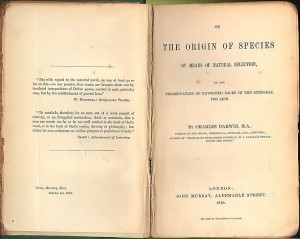 Ever since Darwin, the concept of teleology has been suspect among biologists. What is so controversial about teleology? Most likely, its history! From the earliest Greek philosophers on, it was widely believed that the world must have a purpose because, as Aristotle would put it, “nature does nothing in vain,” and neither does God, as a Jew or Christian would say. In this often misunderstood view, any change in this world is due to final causes that move things to an ultimate goal, a predetermined end. All things would achieve certain ends or goals because they were designed that way by nature or by God; that’s how hormones, for instance, are supposed to reach their target cells.
Ever since Darwin, the concept of teleology has been suspect among biologists. What is so controversial about teleology? Most likely, its history! From the earliest Greek philosophers on, it was widely believed that the world must have a purpose because, as Aristotle would put it, “nature does nothing in vain,” and neither does God, as a Jew or Christian would say. In this often misunderstood view, any change in this world is due to final causes that move things to an ultimate goal, a predetermined end. All things would achieve certain ends or goals because they were designed that way by nature or by God; that’s how hormones, for instance, are supposed to reach their target cells.
However, this belief came under attack when scientists—still called “natural philosophers” at the time—began searching for physical and material explanations, for eternal physical laws that regulate falling bodies and the motion of planets. It is at this point in the discussion that Charles Darwin comes into the picture. He replaced teleological explanations with physical explanations in terms of what he called natural selection. According to some, Darwin rephrased teleology from an “a priori drive” to an “a posteriori result.” Was this the end of teleology? Darwin may have thought it was, but let’s find out.
Biology Has a Teleological Dimension
What makes biology so inherently teleological? Biological features can be understood in terms of effects—that is, in terms of survival problems that need to be effectively solved. In other words, they serve a function; the green color of a caterpillar has a function, namely, to deceive potential predators; such is their end or goal—or in more neutral, biological terms, such is their function. One could also say that camouflage is “for” deceiving, just like a knife is “for” cutting. So in biology, it remains very common to ask what a feature is “for.” Just like pumps are for pumping (that’s their desired effect), so eye patterns on butterfly wings are “for” protection (that’s the advantageous effect it has on fending enemies off). This is a function of eye patterns, but certainly not a purpose or intention of butterflies.
Prior to any talk of evolutionary theory, William Paley (1743-1805) had argued that something as beautifully designed as the universe must have had a Designer, just like a watch does. In the footsteps of Paley, Darwin also saw a beautiful design in nature, but unlike Paley, he viewed nature as something designed by the trial-and-error test of natural selection during a process of evolutionary change. No matter what, in either case, the results must be design-like (in the sense of well-adapted), because if they were not, they simply would not work in solving problems. If the eye lens, for example, did not function like a physical lens, one would not see very well. There is teleology again.
Apparently, biological features can have and do have effects that are advantageous (or detrimental) to various degrees. But how that is possible in itself is an altogether different story—actually a meta-physical story.
The Metaphysics of Teleology
Somehow our universe has been designed in such a way that specific designs do work, whether it is for better or for worse. It is only due to this metaphysical notion of design and teleology that we can talk about biological designs; all biological designs are “design-based” designs. It is one of the most perplexing things about our universe that it allows for any kind of design to work the way it works.
Did Darwin ignore this part of the story? Or did he really discard teleology? Some keep stressing that he replaced teleology with the causality of natural selection. One of them was George Bernard Shaw who once said that Charles Darwin threw Paley’s “watch” into the ocean. Well, Shaw was wrong. If Darwin did throw something away, it was Paley’s “watchmaker,” but certainly not his famous “watch.” Darwin never threw away the design concept—it was actually essential to his theory.
The artifact analogy of design is as basic to Darwinism as it is to Paley’s natural theology. Since the heart is designed like a pump, it is a successful design “for” circulating blood. After Darwin, the heart still existed “for” circulation; the cause of its existence may have been different, but its teleology was not. However, Darwin ignored, or at least bypassed, the following question: How come that certain biological designs “work,” and are “successful” and “effective” in reaching their “goal”? What is it that makes them “goal-directed”? What carries them through the filter of natural selection?
It’s here that teleology keeps coming back. There is teleology in the biological world because the animate world is design-like—as much so as there is teleology in the technical world of designers because that world is design-like as well. Natural selection may explain that a fine working design has a better chance of being reproduced, but ultimately it cannot explain why such a design is working so well.
And that’s where teleology is needed—even in Darwinism. In that sense, Darwin did not change teleology from an “a priori drive” into an “a posteriori result.” Teleology is not a biological outcome a posteriori but a metaphysical given a priori. Natural selection does not create teleology, but its working is based on teleology.
Where Does Teleology Come From?
The answer may seem mystifying at first sight: Teleology must have been built into nature—as some kind of all-pervasive architecture. It may be so all-pervasive, though, that it easily escapes attention. Natural selection on its own cannot do the “job” unless it works within a framework of purpose and design. Without this “cosmic design,” there couldn’t even be any natural selection. Natural selection can only select those specific designs that are in accordance with the cosmic design (by the way, designers, engineers, and architects must do the same thing).
As it turns out, science does not operate in a vacuum, but it works within a philosophical framework of pre-existing assumptions—and one of them is teleology (some call it cosmic teleology, in distinction from the older idea that biological designs are the product of predetermined goals). Darwin may have thought he could reduce teleology to causality, but his causality mechanism of natural selection can only work on condition that there is teleology in nature. There is “something” in successful biological designs that carries them through the filter of natural selection. To put it briefly, organisms are not teleological because they have survived; on the contrary, their survival is mainly due to the fact that they are teleological. Creation is “loaded” with cosmic design, just like a dice that constantly throws a six must be loaded.
Let me come to a conclusion. The inescapable idea behind all of this is that our universe is ultimately an “intelligent project,” created by an Intelligent Designer. The assumption of a Creator would explain that the universe exists and is what it is; and the assumption of a cosmic design would explain why the universe is this way. In that sense, even Darwinism needs some Divine Help—whether its fans like it or not. There is no way Darwinism could survive without teleology.
 Written by Gerard M. Verschuuren
Written by Gerard M. Verschuuren
Used with permission
Gerard M. Verschuuren is a human geneticist who also earned a doctorate in the philosophy of science. He studied and worked at universities in Europe and the United States. His latest books include God and Evolution?: Science Meets Faith (Pauline Books, 2012), What Makes You Tick: A New Paradigm for Neuroscience (Solas Press, 2012), Darwin’s Philosophical Legacy: The Good and the Not-So-Good (Lexington Books, 2012), Of All That Is, Seen and Unseen (Queenship Publishing, 2012), and his upcoming book The Destiny of the Universe: In Pursuit of the Great Unknown (Paragon House, 2014). He can be contacted at Where-Do-We-Come-From.com.



